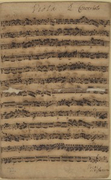Bach 330: The Brandenburg Concerto Manuscript at the Library of Congress
Thursday, March 19, 2015

It’s Johann Sebastian Bach’s 330th birthday on Saturday! Please enjoy this article about a Bach manuscript at the Library of Congress, written by Daniel Boomhower (who is also a member of RISM’s Coordinating Committee). It originally appeared on the library’s In the Muse blog.
In May, 1723, Johann Sebastian Bach began, following his appointment as the Cantor at St. Thomas School and Director of Music in Leipzig, a period of creative activity of staggering productivity. In fulfillment of his responsibility for providing sacred music for the principal churches of Leipzig, Bach introduced a new cantata on a weekly basis for three straight years, if not longer. In some instances he repurposed cantatas written at earlier points in his career, but on the whole between 1723 and 1729, Bach wrote a new composition of approximately 25 minutes in length on a weekly basis, not to mention additional service music, including the Sanctus in D, BWV 232III, the Magnificat, BWV 243, the St. Matthew Passion, BWV 244, and the St. John Passion, BWV 245.
Interestingly, to accomplish this Herculean task, Bach would not only use cantatas he had written previously, but would draw also on his non-vocal compositions for musical material for new compositions. A good example of this practice is found in a wedding cantata from approximately 1729 that survives in fragmentary form, Herr Gott, Beherrscher aller Dinge, BWV 120a. Here the Prelude of the Partita in E major for solo violin, BWV 1006 was arranged as an instrumental sinfonia for strings, two oboes, organ, and continuo. This same music was then further embellished for a cantata for the city council elections of 1731, Wir danken dir, Gott, wir danken dir, BWV 29. The music of the opening chorus of the latter cantata was used in different guises in earlier and later compositions, achieving greatest acclaim as nineteenth and twentieth century audiences became familiar with it as the basis of the “Gratias agimus tibi” and “Dona nobis pacem” movements of the Mass in B minor, BWV 232.
This is all to say that Bach re-used music in many ways and on many occasions. For his cantatas, he mined in particular older concerto movements for re-use as instrumental introductions. Of the small number of J. S. Bach manuscripts at the Library of Congress, a rather unassuming viola part from the cantata Ich liebe den Höchsten von ganzem Gemüthe, BWV 174, contains a delightful surprise. In this cantata for the Monday after Pentecost, first performed on June 6, 1729, Bach drew on the music of a concerto from his time in Weimar or Cöthen — a concerto that would serve as the third in the set of six concertos that he would dedicate to the Margrave of Brandenburg in 1721. As with most instances where Bach drew on previously existing music, he made noticeable changes to this concerto movement composing new parts for two horns and adding a choir of oboes and strings against which the solo group of three violins, three violas, and three cellos would contrast. The viola part at the Library of Congress (labelled “Viola. 2. Concertato”) dates from the original performance of this cantata in 1729 and reflects the work of two copyists working under Bach’s supervision. It also contains one addition in the hand of J. S. Bach: the word “Concertato” was added to the heading of this part as well as to the other string parts that survive in several other collections in the United States and Germany.
Image: Original manuscript of the second viola part for J. S. Bach’s cantata “Ich liebe den Höchsten von ganzem Gemüte,” BWV 174, from the year 1729.
View records for this cantata in the RISM online catalog.
Share Tweet EmailCategory: Musical anniversaries

